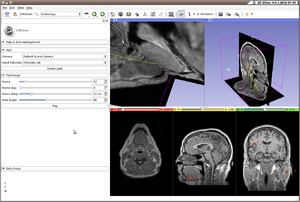AHM2012-Slicer-Python
Contents
What is accessible via python
Qt
Interfaces are build with PythonQt which exposes most of the Qt interface so that sophisticated interfaces can be easily created.
import slicer
def widgetTree(root=""):
if not root:
root = slicer.util.mainWindow()
global treeItems
tree = qt.QTreeWidget()
tree.setHeaderLabels(["Widget", "Class", "Title", "Text", "Name"])
treeItems = {}
treeItems[root] = qt.QTreeWidgetItem(tree)
parents = [root]
while parents != []:
widget = parents.pop()
if not widget:
break
widgetItem = qt.QTreeWidgetItem(treeItems[widget])
children = widget.children()
for child in children:
treeItems[child] = widgetItem
parents += children
widgetItem.setText(0, str(widget))
try:
widgetItem.setText(1, widget.className())
except AttributeError:
pass
try:
widgetItem.setText(2, widget.title)
except AttributeError:
pass
try:
widgetItem.setText(3, widget.text)
except AttributeError:
pass
try:
widgetItem.setText(4, widget.name)
except AttributeError:
pass
tree.setGeometry(100, 100, 1000, 500)
tree.setColumnWidth(0,200)
tree.setColumnWidth(0,300)
tree.expandAll()
tree.show()
return tree
VTK and MRML
It is possible to implement the logic of the effect using VTK Python binding. You can get ideas of what is possible from the VTK tutorials.
Because MRML and most of the slicer functionality is written as VTK subclasses, they are available in python via the same mechanism.
class EndoscopyPathModel:
"""Create a vtkPolyData for a polyline:
- Add one point per path point.
- Add a single polyline
"""
def __init__(self, path, fiducialListNode):
fids = fiducialListNode
scene = slicer.mrmlScene
points = vtk.vtkPoints()
polyData = vtk.vtkPolyData()
polyData.SetPoints(points)
lines = vtk.vtkCellArray()
polyData.SetLines(lines)
linesIDArray = lines.GetData()
linesIDArray.Reset()
linesIDArray.InsertNextTuple1(0)
polygons = vtk.vtkCellArray()
polyData.SetPolys( polygons )
idArray = polygons.GetData()
idArray.Reset()
idArray.InsertNextTuple1(0)
for point in path:
pointIndex = points.InsertNextPoint(*point)
linesIDArray.InsertNextTuple1(pointIndex)
linesIDArray.SetTuple1( 0, linesIDArray.GetNumberOfTuples() - 1 )
lines.SetNumberOfCells(1)
# Create model node
model = slicer.vtkMRMLModelNode()
model.SetScene(scene)
model.SetName("Path-%s" % fids.GetName())
model.SetAndObservePolyData(polyData)
# Create display node
modelDisplay = slicer.vtkMRMLModelDisplayNode()
modelDisplay.SetColor(1,1,0) # yellow
modelDisplay.SetScene(scene)
scene.AddNodeNoNotify(modelDisplay)
model.SetAndObserveDisplayNodeID(modelDisplay.GetID())
# Add to scene
modelDisplay.SetPolyData(model.GetPolyData())
scene.AddNode(model)
# Camera cursor
sphere = vtk.vtkSphereSource()
sphere.Update()
# Create model node
cursor = slicer.vtkMRMLModelNode()
cursor.SetScene(scene)
cursor.SetName("Cursor-%s" % fids.GetName())
cursor.SetAndObservePolyData(sphere.GetOutput())
# Create display node
cursorModelDisplay = slicer.vtkMRMLModelDisplayNode()
cursorModelDisplay.SetColor(1,0,0) # red
cursorModelDisplay.SetScene(scene)
scene.AddNodeNoNotify(cursorModelDisplay)
cursor.SetAndObserveDisplayNodeID(cursorModelDisplay.GetID())
# Add to scene
cursorModelDisplay.SetPolyData(sphere.GetOutput())
scene.AddNode(cursor)
# Create transform node
transform = slicer.vtkMRMLLinearTransformNode()
transform.SetName('Transform-%s' % fids.GetName())
scene.AddNode(transform)
cursor.SetAndObserveTransformNodeID(transform.GetID())
self.transform = transform
Numpy
Slicer also comes bundled with numpy so many interesting array operations are easy to perform on image data.
Here's an excerpt from a working example:
#
# Get the numpy array for the bg and label
#
import vtk.util.numpy_support
backgroundImage = backgroundNode.GetImageData()
labelImage = labelNode.GetImageData()
shape = list(backgroundImage.GetDimensions())
shape.reverse()
backgroundArray = vtk.util.numpy_support.vtk_to_numpy(backgroundImage.GetPointData().GetScalars()).reshape(shape)
labelArray = vtk.util.numpy_support.vtk_to_numpy(labelImage.GetPointData().GetScalars()).reshape(shape)
It is also possible to invoke slicer command line modules from python. These can be written in any language, but often rely on ITK for processing. In the near future SimpleITK should be available directly inside slicer.
See the Slicer4 Python page for examples.
Using the console
(See J2's excellent demo video)
Writing a Scripted Module
- PythonQt interface
- Logic with vtk/vtkITK/CLI Modules
- Accessing MRML Data via numpy

